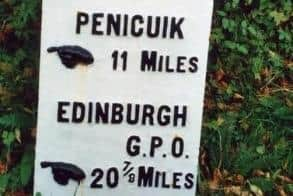Scotland’s mileposts have a fascinating tale to tell - Bruce Keith
Sir Robert Sibbald had a keen eye for detail. He was the founding President of the Royal College of Physicians, the first Professor of Medicine at Edinburgh University and founded the city’s Royal Botanic Gardens. On a visit to friends at Ingliston in 1697, his eagle eye also found a Roman milestone. It’s a sandstone pillar, now in the National Museum of Scotland.
Roman soldier and engineer, Agrippa, devised the “mille passus” being the distance covered by the left foot hitting the ground one thousand times. To ensure consistency, he calibrated each pace at five lengths of his own foot. Thus routes were measured and soldiers on the march would have resort to stone pillars to answer that age-old plea known to every parent, “are we nearly there yet?”.
Advertisement
Hide AdAdvertisement
Hide AdReaders subject to the rigours of a Scottish education will have realised that the modern mile is somewhat shorter at 4,840 feet, although the measurement has been through several incarnations since Agrippa’s days. In Tam o’Shanter, Burns reflects on the “lang Scots miles”…and a mile measuring 5,952 feet persisted until 1824 when the Uniform Weights & Measures Act aimed to stop “great confusion and frauds”.


The advent of the Turnpike Acts from the early 18th century onwards required milestones to be placed on turnpike roads, although it was not until the 1750s that turnpikes became fashionable in Scotland – the system lasting until the 1880s when rail travel saw off road charging. It was Ayrshireman John Loudon McAdam and his family who championed the turnpike trusts, holding surveyorships across both Scotland and England. He also developed an improved road construction technique using smaller, broken stones, although his name is so frequently mis-called for “inventing” tarmacadam.
In 1859, of the 21,318 miles of road in Scotland, some 5,637 miles were turnpike, whilst almost two-thirds comprised old statute labour or parish roads. The balance of 1,245 miles were the remnants of the military and Parliamentary roads of Wade, Caulfeild and Telford.
From the locally-quarried red granite milestone near Dervaig on Mull to the cast iron “railway style” milepost near Kilsyth produced by the foundry in Bonnybridge; from the series of Post Horse Duty stones, five miles distant from the GPO in Edinburgh, positioned to regulate the fares of hackney carriages, to the dual-purpose Victorian pillar box which once stood in Portobello’s High Street, they are all a key part of Scotland’s transport and social heritage.
Even those Millennium mileposts, located along Sustrans National Cycle Network, and comprising four strangely designed sculptures will have their tales to tell.


Satnav may well have displaced the need for mileposts in modern travel, but along the way our wayside heritage is worthy of restoration and conservation.
Bruce Keith on behalf of CILT. Are We Nearly There Yet? by Keith Bruce is available from [email protected] priced £20, including postage and packing.
Comments
Want to join the conversation? Please or to comment on this article.